Saltwater algae eaters are highly desirable additions to every saltwater aquarium, especially reef tanks. Every tank will encounter various types of algae problems. Having clean-up crew critters that will eat algae and are reef-safe are a smart addition.
This in-depth guide covers all algae eaters and explains the types of algae they eat. Keep reading to find the perfect algae eaters for your aquarium.
Table of Contents
Algae Eating Saltwater Fish
If you have problems with algae in your tank, you can get a saltwater fish with a big appetite for nuisance algae. They bring a lot of personality and utility to reef tanks, so let’s have a look at the 21 best algae-eating fish.

Lawnmower Blenny
Algaes Known To Eat: Filamentous algae, diatoms, hair algae
Description
Also known as the Rock Skipper or Jewelled Blenny, the Lawnmower blenny is a utility fish often used as part of a clean-up crew to take care of algae issues. The looks of this fish might remind you of an iguana or a lizard, and it has a curious and endearing personality.
Reef-Compatibility
They are known for nipping SPS corals and clam mantles, so they’re not considered entirely reef tank safe.
They are aggressive towards fish with a similar shape or appearance, and they should be kept singly or in a mated pair.
- Minimum Tank Size: 30 gallons
- Mature Size: 5 inch
- Care Difficulty: Easy
- Diet: Herbivore

Achilles Tang
Algaes Known To Eat: Micro and macroalgae
Description
The Achilles Tang is a beautiful surgeonfish that requires a lot of care and attention. Aquarists should only keep it with a lot of experience in fishkeeping.
Reef-Compatibility
The Achilles Tang is very aggressive towards others in the same species and even other surgeonfish. They will interact peacefully with other small and peaceful fish. You should only keep one per tank.
The Achilles tang needs fast-moving water and a lot of water volume to swim around. You should always try to put their needs first because they are delicate to tank parameters.
- Minimum Tank Size: 180 gallons
- Mature Size: 8½ inches
- Care Difficulty: Expert
- Diet: Herbivore
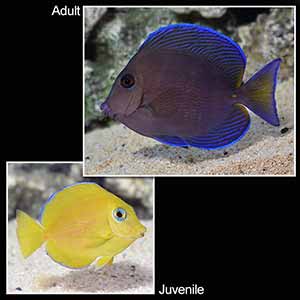
Atlantic Blue Tang
Algaes Known To Eat: Blue-green algae, brown algae, green algae, and red algae, and they are sometimes known to feed on seagrass
Description
The Atlantic blue tang or the Blue tang surgeonfish is a surgeonfish with an oval body with bold markings that are different when the fish matures. As a juvenile, the fish is bright yellow with only two blue bands around the eyes. As the fish grows, the fish will turn blue with horizontal markings along the entire body and tiny hints of yellow on the tail.
Reef-Compatibility
The Atlantic blue tang is aggressive towards other surgeonfish and tangs but can live peacefully with other fish. It’s best to keep the Atlantic blue tang singly and without any other surgeonfish in the reef tank.
They are ideal for controlling algae growth, but this species can start nipping the Large Polyp Stony corals in the aquarium if they are not well fed.
- Minimum Tank Size: 180 gallons
- Mature Size: 9 inch
- Care Difficulty: Moderate
- Diet: Herbivore
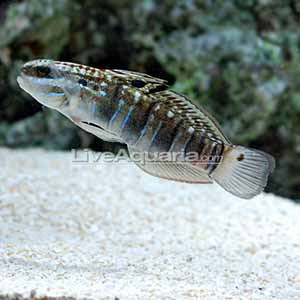
Brown Barred Goby
Algaes Known To Eat: Filamentous algae
Description
The Brown Barred Goby or Bullet Goby was first discovered in 1837 in the Indo-Pacific Ocean. This fish has a greenish-yellow head with orange and blue dashes and dots. The rest of the body is yellow, and it has brown bands up until the tail.
Reef-Compatibility
The Brown Barred Goby is aggressive with its kind and fights for the same territory. It doesn’t show aggressiveness towards other fish. This fish should keep it singly or as a mated pair.
- Minimum Tank Size: 30 gallons
- Mature Size: 6 inch
- Care Difficulty: Easy
- Diet: Omnivore

Brown Scopas Tang
Algaes Known To Eat: Filamentous algae
Description
The Brown Scopas Tang or Scopas Tang is a yellow and brown fish. These colors gradually get darker from front to back, and the body is covered with light and fine blue markings. The tail is brown. The juveniles have a slightly purplish body color and therefore look more attractive.
Reef-Compatibility
Brown tangs are the easier tang for beginners. They do not bother corals and are safe to keep in a reef tank. Since they are more tolerant of living conditions and more readily available, they are perfect for novice aquarists.
Brown tangs are the least aggressive of their genus and can be kept in the same aquarium with other species of tangs.
- Minimum Tank Size: 125 gallons
- Mature Size: 16 inch
- Care Difficulty: Moderate
- Diet: Herbivore
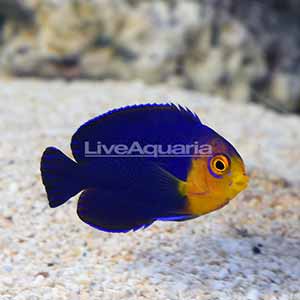
Cherub Angelfish
Algaes Known To Eat: Filamentous algae, Spirulina
Description
The Cherub Angelfish is one of the most popular and hardy members of the Angelfish family and one of the best species to keep in the reef tank. They bring a lot of color to your aquarium with brilliant blue bodies and golden faces.
Reef-Compatibility
The Cherub angelfish has been reported to nip at clam mantles and LPS corals.
It is also an aggressive little fish, and you shouldn’t have more than one male in your aquarium as they will fight to the death. You should keep it singly or in a mated pair.
- Minimum Tank Size: 55 gallons
- Mature Size: 3 inches
- Care Difficulty: Moderate
- Diet: Omnivore
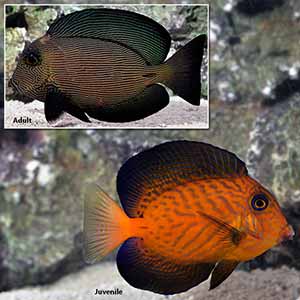
Chevron Tang
Algaes Known To Eat: Diatoms, blue-green algae, and green algae
Description
The Chevron tang is a beautiful fish, especially as a juvenile. It has a bright orange body with bright blue lines all over the body at a young age. The fins are violet and blue. The adult has a dark-orange coloration with multiple green-blue stripes, much darker and numerous than a juvenile. When seen from a distance, the Chevron tang looks like it has a black uniform. Therefore his other name is Black surgeonfish.
Reef-Compatibility
The Chevron tang is not very aggressive and can be kept with other peaceful fish species. In general, avoid keeping it with fish with similar body color, shape, or diet. They can be territorial with other tangs, so keep an eye on them if you have more than one.
This fish is considered reef safe as it will leave invertebrates and corals alone. Large specimens can cause damage when they feed, but that is rarely a problem.
- Minimum Tank Size: 75 gallons
- Mature Size: 11 inches
- Care Difficulty: Intermediate
- Diet: Herbivore
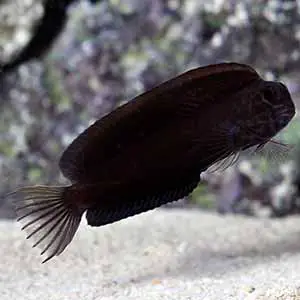
Combtooth Blenny
Algaes Known To Eat: Microalgae
Description
The Combtooth Blenny, Namive’s blenny, Yellowtail Black Blenny, or Tribal Blenny are rare in home aquariums. If you happen to buy one from a shop, you’ll cause a lot of envy among friends.
The name of this fish comes from the multitude of fine teeth (about 100) that are embedded in their lips. These teeth help scrape algae from rocks and the aquarium walls.
They pack a lot of personality and are incredibly active at scraping the algae from the rocks.
Reef-Compatibility
The Combtooth Blenny is a peaceful fish that will get along well with different tank mates, but they will have a problem with the same species or a fish with a similar appearance. It should be kept in a mated pair or singly.
Although this fish is considered reef safe, there have been reports of nipping clam mantles and various corals.
- Minimum Tank Size: 30 gallons
- Mature Size: 4 inches
- Care Difficulty: Easy
- Diet: Herbivore
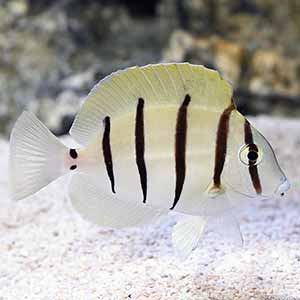
Convict Tang
Algaes Known To Eat: Micro and macroalgae
Description
Convict tangs don’t bring a lot of color to a saltwater aquarium, but they sure get a charming personality and flashy stripes. These surgeonfish are a great addition to a saltwater tank, and they have a look that resembles a prison jumpsuit, hence their name.
Reef-Compatibility
Convict tangs are peaceful with other non-aggressive fish, but they will be aggressive with other tangs or fish with a similar appearance. If they have enough to eat, they will generally leave corals and invertebrates alone.
They love to feed on the algae that make the reef tank unappealing.
- Minimum Tank Size: 100 gallons
- Mature Size: 8 inches
- Care Difficulty: Intermediate
- Diet: Herbivore

Foxface Rabbitfish
Algaes Known To Eat: Green hair, bryopsis, and bubble algae
Description
The Foxface Rabbitfish or Foxface lo is a fish with unique body color. The fish’s body is yellow, but the face is white with two black stripes on it. They are a very resilient fish and a great addition to a clean-up crew.
Reef-Compatibility
The Foxface Rabbitfish is aggressive towards its species but peaceful to other types of fish. It can be housed with other aggressive fish because predators leave it alone due to its venomous dorsal spines.
They are considered reef safe if they are well fed, being ferocious saltwater algae eaters. When hungry, they might nip and consume soft corals and LPS corals.
- Minimum Tank Size: 125 gallons
- Mature Size: 10 inches
- Care Difficulty: Easy
- Diet: Herbivore
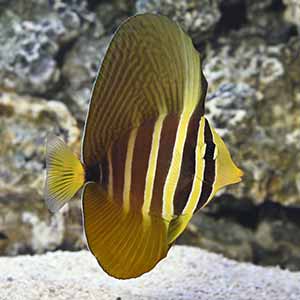
Sailfin Tang
Algaes Known To Eat: Leafy microalgae
Description
One of the more amicable members of the tang family, sailfin tangs, still tends to get territorial around other tangs. It is a beautiful, colorful fish that looks similar to its close relative to the Desjardin’s sailfin tang. It is more common and is less expensive.
Sailfin tang is one of the friendliest members of the tang family. However, they tend to get territorial when other tangs are around. This is a beautiful brown body fish with vertical yellow stripes all over it.
Reef-Compatibility
Like other fish from the surgeonfish family, Sailfin tangs don’t play well with fish from the same species. They are territorial and will fight other Sailfin tangs. If there are other surgeonfish in the tank, Sailfin tang might get bullied. Keep it by itself or with a mated pair.
It doesn’t usually bother invertebrates or corals, but they can sometimes get the bad habit of nipping polyps of fleshy LPS corals or clam mantles.
- Minimum Tank Size: 125 gallons
- Mature Size: 15 inches
- Care Difficulty: Easy to intermediate
- Diet: Herbivore
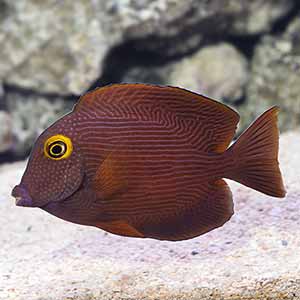
Kole Tang
Algaes Known To Eat: Filamentous algae, slime algae
Description
The Kole Tang or Yelloweye surgeonfish is a chocolate brown body fish with yellow eyes. It has a similar look to the Indian gold ring, but it’s much more commonly available than the former. The Kole tang has thin blue stripes all over its body that turn into spots on the head.
Reef-Compatibility
It is aggressive towards other Tangs. Therefore, it is best only to keep one per tank. It will not harm sessile invertebrates in the reef tank environment.
This species is very aggressive towards other tangs, so it should be kept as the only tang in the tank. It will not harm invertebrates or corals, focusing only on eating algae.
- Minimum Tank Size: 70 gallons
- Mature Size: 7 inches
- Care Difficulty: Moderate
- Diet: Herbivore
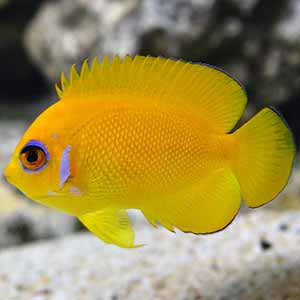
Lemonpeel Angelfish
Algaes Known To Eat: Macroalgae, diatoms
Description
The Lemonpeel angelfish is one of the most beautiful dwarf angelfish you can have in a reef tank, bringing a lot of energy and color. The body is bright yellow, and they have a blue ring around the eye. When juvenile, this fish also has a black eyespot on the side of its body.
Reef-Compatibility
The Lemonpeel angelfish are solitary by nature and like to stay close to shelter. It will be aggressive towards other angelfish, and if two males of the species are in the tank, they will fight to the death. You can keep them in pairs or trio (one male with two females) if they have been introduced simultaneously.
This species is known for nipping LPS corals and clam mantles. They can also develop a nipping habit for softies and zoas.
- Minimum Tank Size: 30 gallons
- Mature Size: 5.5 inches
- Care Difficulty: Intermediate
- Diet: Omnivore
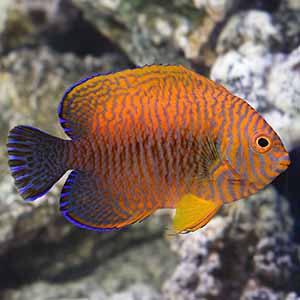
Potter’s Angelfish
Algaes Known To Eat: Benthic algae
Description
The Potter’s Angelfish has a bright rusty orange body with blue lines over the body. The orange darkens to black/blue on the lower side of the body. The males have a more pronounced dark area and more elongated bodies.
Reef-Compatibility
The Potter’s angelfish will show aggression towards the members of the same species and from the Centropyge genus. It has an excellent survival rate in reef tanks, but they are not entirely reef safe.
This species might pick at invertebrates and corals, including stony corals, clam mantles, and zoas. However, this is different for each fish, and some might never cause problems at all.
- Minimum Tank Size: 70 gallons
- Mature Size: 5 inches
- Care Difficulty: Difficult
- Diet: Omnivore

Powder Blue Tang
Algaes Known To Eat: Benthic algae
Description
The Powder Blue Tang or Powder blue surgeonfish has an oval shape and vivid colors. The body is blue with a variation of shades, accented by white and yellow. A bright yellow color is present on the pectoral and dorsal fins, while black and blue markings outline the tail and face.
Reef-Compatibility
This fish is highly aggressive towards other surgeonfish and tangs, especially those with the same colors and shape. You can only have one Powder blue tang in the aquarium, except for having a large quantity of water and introducing the members all at once.
- Minimum Tank Size: 125 gallons
- Mature Size: 9 inches
- Care Difficulty: Moderate
- Diet: Herbivore

Powder Brown Tang
Algaes Known To Eat: Blue-green microalgae, red algae
Description
The Powder brown tang or Japan Surgeonfish has a brown body with a distinctive white mark between the mouth and eyes. The fins are dark brown with highlights of blue at the tip. There’s also an orange stripe on the dorsal fin. The tail is light blue with a yellow vertical stripe.
Reef-Compatibility
You should only keep one Powder brown tang per tang and don’t house it with other surgeonfish or tangs, as it may attack them. This species is highly aggressive towards similarly-looking tangs.
It doesn’t nip on corals and invertebrates, so it’s considered a reef-safe fish.
- Minimum Tank Size: 125 gallons
- Mature Size: 8 inches
- Care Difficulty: Moderate
- Diet: Herbivore
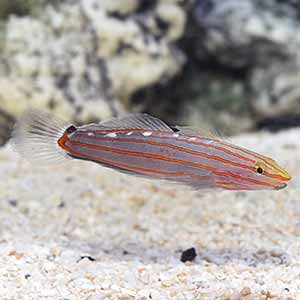
Rainford’s Goby
Algaes Known To Eat: Filamentous algae
Description
The Rainford’s Goby or Court Jester Goby is a timid and peaceful fish that is an excellent addition to any aquarium. It was first discovered in 1940 in the Western Pacific, and its brightly colored body inspired its name. The body is blue and green, and it has horizontal orange stripes all over its body.
Reef-Compatibility
The Rainford’s goby is not aggressive towards other species, but it will fight other members of the same species. You can keep it with other non-aggressive fish, and they won’t nip at corals or clams.
- Minimum Tank Size: 10 gallons
- Mature Size: 3 inches
- Care Difficulty: Moderate
- Diet: Omnivore
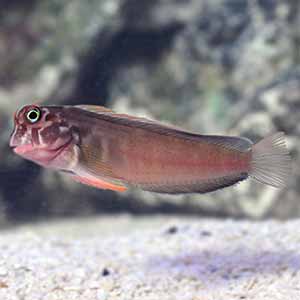
Redlip Blenny
Algaes Known To Eat: Microalgae
Description
The Red Lip Blenny or Horseface Blenny is a fish from the Caribbean Ocean. The body is black and red with yellow markings on the fins. The fish has 4 small branching horns on its head and a very blunt nose, which gives it a horse-like appearance.
Reef-Compatibility
The Horseface Blenny is a peaceful fish unless the tank mates resemble its shape and color. It should be kept singly or in a mated pair.
It has been reported to nip at clam mantles occasionally and small-polyp stony corals. Therefore you should keep an eye on it.
- Minimum Tank Size: 30 gallons
- Mature Size: 5 inches
- Care Difficulty: Moderate
- Diet: Herbivore
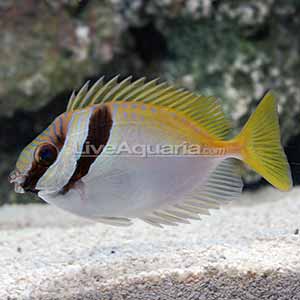
Scribbled Rabbitfish
Algaes Known To Eat: Hair algae, valonia, red turf algae
Description
The Scribbled rabbitfish brings a lot of color and energy to a reef tank. It has a magnificent combination of metallic silver, blue, green, and yellows all over its body, forming intricate patterns that please the eye.
Reef-Compatibility
This fish is territorial, and it will show aggression towards members of the same species or those that resemble their appearance. The Scribbled Rabbitfish might nip at soft corals and LPS corals; therefore, you should use caution.
- Minimum Tank Size: 60 gallons
- Mature Size: 10 inches
- Care Difficulty: Intermediate
- Diet: Herbivore

Sphinx Goby
Algaes Known To Eat: Green and red algae
Description
The Sphinx goby has a yellow-brown body with 5 or 6 dark brown vertical bars separated by white markings. The fish also has a row of small black spots, widely spaced along the back.
Reef-Compatibility
This fish loves to burrow itself in the sand, and it will get along with other peaceful tank mates in the aquarium. However, it will not tolerate members of the same species.
- Minimum Tank Size: 70 gallons
- Mature Size: 7 inches
- Care Difficulty: Moderate
- Diet: Omnivore

Yellow Tang
Algaes Known To Eat: Filamentous algae
Description
The Yellow tang or the Yellow Hawaiian Tang is the fish many aquarists love to have. The Yellow tang has no problem taking the spotlight and brightening the reef tank with an oval-shaped body and vibrant yellow color. This fish is an active swimmer, and it will glide through the water in constant motion. It is truly a mesmerizing fish.
Reef-Compatibility
Like other tangs, this fish is aggressive towards its species and other tangs in general. Keep it alone or in a mated pair. If you want to have multiple Yellow tangs in your tank, make sure you introduce them simultaneously.
- Minimum Tank Size: 100 gallons
- Mature Size: 8 inches
- Care Difficulty: Easy
- Diet: Herbivore
Algae Eating Saltwater Snails
Snails are a great addition to a clean-up crew, but not all snails are algae eaters. These slow tank inhabitants will work tirelessly to clean your rocks and aquarium glass of nuisance algae. Let’s see the best algae-eating snails.

Astraea Snail
Algaes Known To Eat: Hair algae, brown algae, green algae, diatoms, filamentous algae
Description
Astra snails are very common in a saltwater aquarium. Hobbyists don’t even have to buy it because this snail can sometimes hitchhike to a reef tank attached to corals or live rocks. They are hardy snails and love to munch on algae, and therefore one of the favorites for a clean-up crew.
Reef-Compatibility
Astrea snails are reef safe and will not snack on corals or damage anything in the reef tank. Their small size prevents them from knocking over any freestanding corals that might be in their way at the bottom.
- Minimum Tank Size: 5 gallons
- Mature Size: 1 inch
- Care Difficulty: Easy
- Diet: Herbivore
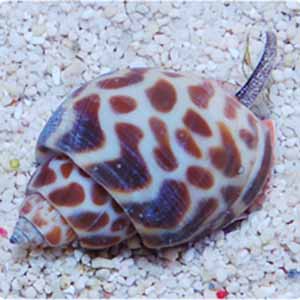
Babylonia Snail
Algaes Known To Eat: Filamentous algae
Description
Babylonia snails are also called Leopard snails or Tiger Nassarius snails. These more giant snails are a great addition to a reef aquarium that has a sand bed. They are nocturnal animals and are usually visible when the lights are off. The Babylonia snail will clean and aerate your sand while scavenging for decaying organisms and uneaten food.
Reef-Compatibility
The Babylonian snails are efficient scavengers but also mildly predators. There have been reports of preying on tridacnid clams or smaller gastropods. Therefore you should add these snails with care to reef tanks with vulnerable livestock.
- Minimum Tank Size: 24 gallons
- Mature Size: 3 inches
- Care Difficulty: Intermediate
- Diet: Omnivore, Detritivore
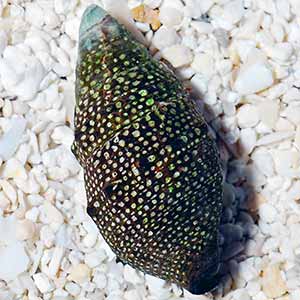
Cerith Snail
Algaes Known To Eat: Microalgae, hair algae
Description
A popular member of CUC in reef aquariums, the Cerith snails are tiny scavengers with pointy shells. They are hardy and can thrive in many water parameters, and they can share the space with other peaceful invertebrates.
Reef-Compatibility
Cerith snails are peaceful scavengers and won’t attack or disturb other tank mates. Because they are small, it’s advantageous to have them in a clean-up crew because they can get into tight spaces, and they won’t knock things over when moving.
Avoid putting the snail with predators such as hawkfishes, triggerfish, dog-faced pufferfish, etc.
- Minimum Tank Size: 10 gallons
- Mature Size: 1 inch
- Care Difficulty: Easy
- Diet: Omnivore
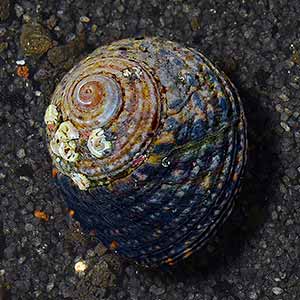
Margarita Snail
Algaes Known To Eat: Microalgae, hair algae
Description
The Margarita snail is a popular choice for reef tank inhabitants. Also known as Little Margarite or Stomatella Limpet, this snail has a brown body and a turban-shaped shell. That’s because they eat large amounts of algae, including the annoying hair varieties. And unlike other snails, they are non-venomous and non-aggressive towards other invertebrates and corals.
This snail is hardy and can adjust to all types of aquarium. It needs an established reef tank with an abundant source of algae to feed.
Reef-Compatibility
The Margarita snail is peaceful towards other fish, invertebrates, and corals. They are non-venomous and therefore are great tank mates.
- Minimum Tank Size: 10 gallons
- Mature Size: 1 inch
- Care Difficulty: Easy
- Diet: Herbivore
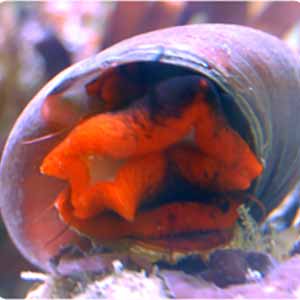
Red Foot Snail
Algaes Known To Eat: Hair algae, filamentous algae, slime algae
Description
The Red foot snail is a fast snail, similar to the Turbo, moving around and cleaning the algae swiftly.
Reef-Compatibility
This snail is non-aggressive towards other invertebrates or corals, making it a great addition to your clean-up crew.
- Minimum Tank Size: 26 gallons
- Mature Size: 3 inches
- Care Difficulty: Easy
- Diet: Herbivore
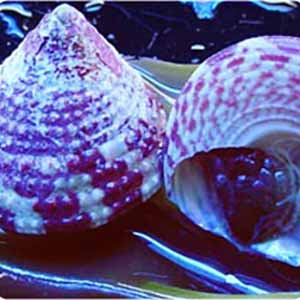
Tiger Turbo Snail
Algaes Known To Eat: Diatoms, microalgae, hair algae
Description
Tiger turbo snails have a turban-shaped shell with a beautiful design that resembles a tiger. They are excellent algae cleaners providing there are enough algae in the tank for them to consume. Their ability to munch on hair algae at great speed makes them a top candidate for keeping the tank clean.
Reef-Compatibility
The Tiger turbo snail is a peaceful snail that will not threaten any fish, invertebrates, or corals. They are non-venomous and friendly, and therefore reef safe.
Minimum Tank Size: 50 gallons
Mature Size: 3 inches
Care Difficulty: Easy
Diet: Herbivore
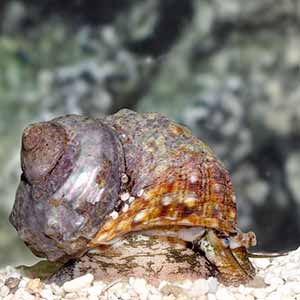
Mexican Turbo Snail
Algaes Known To Eat: Hair algae, microalgae, film algae
Description
The Mexican turbo snail or Turban turbo snail is an excellent member of a clean-up crew. It will quickly eliminate nuisance algae in large amounts, mainly hair algae. It will also clean the algae living off your live rock or glass.
They need to have plenty of hiding places and large spaces to graze. It’s recommended to have well-secured rockwork before placing this snail in the tank because it can bulldoze loose rocks when it searches for food.
Reef-Compatibility
Despite its name, this snail is a slow-moving creature, and therefore you shouldn’t place it with aggressive fish or invertebrates. It can move loose rock if it’s not fixed correctly.
- Minimum Tank Size: 10 gallons
- Mature Size: 2 inches
- Care Difficulty: Easy
- Diet: Herbivore
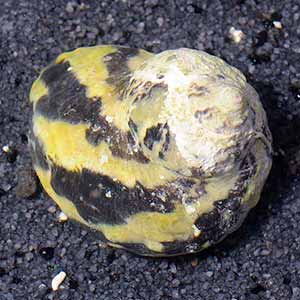
Zebra Turbo Snail
Algaes Known To Eat: Hair algae, film algae
Description
This elegant and beautiful snail is an algae-removal machine. With a massive appetite for algae, the Zebra turbo snail will spend most of its time cleaning your rocks and aquarium glass.
While other turbo species have a simple turban-shaped shell, the Zebra turbo snail has a stunning black shell striped with waves of tan, similar to a zebra. They love to have plenty of hiding places and vast amounts of room to graze on live rock.
Reef-Compatibility
Despite its name, this snail is a slow-moving creature, and therefore you shouldn’t place it with aggressive fish or invertebrates. It can move loose rock if it’s not properly fixed as they spend a lot of time cleaning them.
- Minimum Tank Size: 10 gallons
- Mature Size: 2 inches
- Care Difficulty: Easy
- Diet: Herbivore
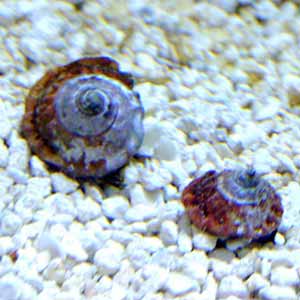
Top Crown Snail
Algaes Known To Eat: Hair algae, cyanobacteria, diatoms
Description
The Top crown snail is one of the best saltwater algae eaters for large saltwater aquariums. It will keep the substrate clean of algae but also the rockwork and aquarium glass. The snail has a beautiful shell with a remarkable top-like shape.
Reef-Compatibility
They are peaceful towards other invertebrates and corals. Keep an eye on them as they can have difficulty righting themselves if they get knocked or fall upside down.
- Minimum Tank Size: 24 gallons
- Mature Size: 2 inches
- Care Difficulty: Easy
- Diet: Herbivore
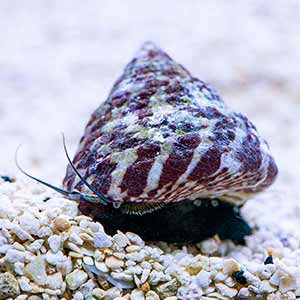
Trochus Snail
Algaes Known To Eat: Film algae, diatoms, hair algae, cyanobacteria
Description
One of the favorites of reef tank invertebrates, Trochus snails have splendid colors and excellent cleaning capabilities. They are peaceful, active, hardy, and easy to breed, and they won’t harm the corals inside the aquarium.
Reef-Compatibility
Trochus snails are solitary by nature and non-aggressive. They can only depend on when attacked, having no means of attacking other tank inhabitants. They prefer to share their space with peaceful tank mates.
There are no reports of Trochus snails attacking corals or invertebrates.
- Minimum Tank Size: 10 gallons
- Mature Size: 2 inches
- Care Difficulty: Easy
- Diet: Omnivore
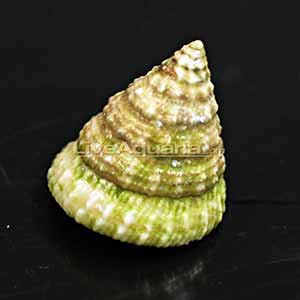
Turban Snail
Algaes Known To Eat: Film algae, diatoms, hair algae, cyanobacteria
Description
Turban snail is a significant algae cleaner and does well in established aquariums with plenty of places to hide. The reef tank should have live rock and a large area for gazing. The snail needs adequate levels of calcium because that’s the primary material for its shell.
Reef-Compatibility
Turban snails are peaceful inhabitants and don’t bother their tank mates or corals. If there are enough algae in the tank to sustain them, Turban snails are suitable for aquariums of all sizes. Due to their small size, they don’t threaten corals, and they don’t move over loose rocks.
- Minimum Tank Size: 20 gallons
- Mature Size: 2.5 inches
- Care Difficulty: Easy
- Diet: Herbivore
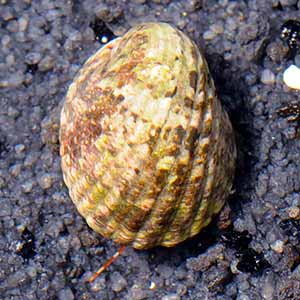
Nerite Snail
Algaes Known To Eat: Film algae, green algae, brown algae, diatoms
Description
Nerite snails are a popular choice for a clean-up crew, and they’re easy to find in local shops. They have a reputation for being outstanding and efficient algae cleaners.
Reef-Compatibility
Nerite snails are peaceful creatures that don’t cause problems for other tank inhabitants or corals. They aren’t very active, but they are excellent algae cleaners.
Don’t place them with aggressive tank mates, as they can quickly become a snack.
- Minimum Tank Size: 5 gallons
- Mature Size: 1 inch
- Care Difficulty: Easy
- Diet: Herbivore
Algae Eating Saltwater Crabs
Crabs bring a lot of utility and style to a reef tank. These little guys love to munch on algae because it’s easy prey. However, hermit crabs will attack snails as well to use their shell as a new home.
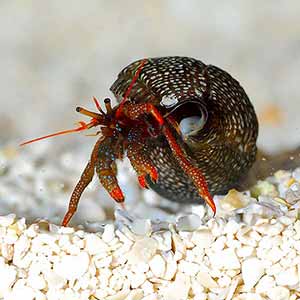
Dwarf Red Tip Hermit Crab
Algaes Known To Eat: Hair algae, diatoms, cyanobacteria
Description
The Dwarf red tip hermit crab is an active scavenger. It is a great member of a reef aquarium’s clean-up crew. This omnivore will scavenge all over your sand substrate and live rock to feed on detritus and algae.
Reef-Compatibility
Don’t place the dwarf red tip hermit crab with other aggressive invertebrates or snails. This crab is peaceful by itself, and it won’t bother your corals or fish. They don’t do well in aquariums where there are large swings in parameters.
- Minimum Tank Size: 5 gallons
- Mature Size: 1 inch
- Care Difficulty: Easy
- Diet: Herbivore
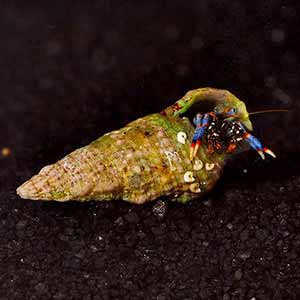
Dwarf Blue Leg Hermit Crab
Algaes Known To Eat: Hair algae, film algae, cyanobacteria
Description
Don’t let the size of this crab fool you. The Dwarf blue leg hermit crab is an active scavenger, always getting into small crevices and openings in live rock to clean your tank of nuisance algae. It will also help aerate your sand substrate, encouraging the activity and growth of beneficial bacteria.
This crab is colorful and reef-safe. It has colorful and bright blue legs with red bands on them and claws of equal size.
Reef-Compatibility
When the Dwarf Blue Leg Hermit Crab is looking for a new home, it may attack snails to obtain their shells or to eat the snails. You might avoid Dwarf Blue Leg Hermit Crabs attacking snails by placing many empty shells inside the reef tank to have something else to pick.
- Minimum Tank Size: 5 gallons
- Mature Size: 1 inch
- Care Difficulty: Easy
- Diet: Omnivore

Halloween Hermit Crab
Algaes Known To Eat: Hair algae, cyanobacteria
Description
With vibrant orange and red legs, the Halloween hermit crab brings a lot of color to a reef tank. It is also a very active clean-up crew member by constantly eating the algae inside the aquarium and scavenging the substrate.
Reef-Compatibility
When the Halloween Hermit Crab is looking for a new home, it may attack snails to obtain their shells or to eat the snails. You might avoid compatibility problems by placing many empty shells inside the reef tank to have something else to pick.
- Minimum Tank Size: 15 gallons
- Mature Size: 2 inches
- Care Difficulty: Easy
- Diet: Omnivore
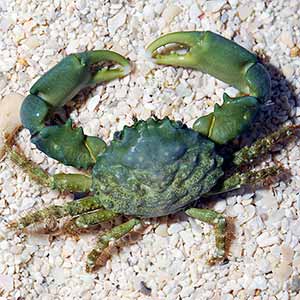
Emerald Crab
Algaes Known To Eat: Bubble algae, microalgae, hair algae
Description
Emerald crabs are beneficial and fun species to have in a reef tank. They have a dazzling emerald green color and lively personality. Being very active algae cleaners, they are a top choice for a CUC.
Reef-Compatibility
Beware of placing the Emerald crabs with other crabs of the same species, as they will fight each other. If the crab doesn’t have enough food, it might snack on snails, small fish, or other invertebrates.
- Minimum Tank Size: 10 gallons
- Mature Size: 2.5 inches
- Care Difficulty: Easy
- Diet: Omnivore
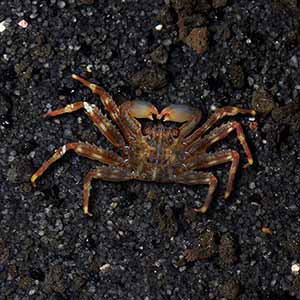
Sally Lightfoot Crab
Algaes Known To Eat: Filamentous algae, calcareous algae, foliose algae, green hair algae
Description
The Sally Lightfoot crab is one of the great saltwater algae eaters, cleaning your tank substrate and live rocks. It will consume everything in its path, including algae, uneaten food, detritus, and pretty much everything. The only diet exception is the corals, which makes the reef safe.
Reef-Compatibility
When it grows big, the Sally Lightfoot Crab will become aggressive and eat small fish and invertebrates. While You might avoid this by providing enough food, you should keep an eye on tank mates that could become prey.
- Minimum Tank Size: 15 gallons
- Mature Size: 3 inches
- Care Difficulty: Easy
- Diet: Omnivore
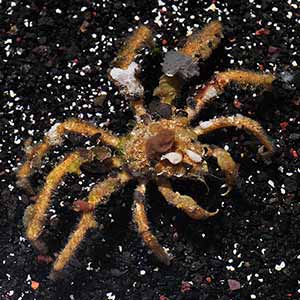
Spider Decorator Crab
Algaes Known To Eat: Seaweed, Hair algae
Description
Spider decorator crab is a different kind of crab. It doesn’t have a look of its own, but rather it will camouflage itself by covering its body with tiny pieces of marine plant, rock, shells, and other items that will keep it stealth. Besides the camouflage that gives it a distinctive look, it also resembles a tarantula, and that’s why it’s also called a Tarantula decorator crab.
Reef-Compatibility
This crab is better suited in a reef tank with plenty of hiding spots between live rock. It would be best if you didn’t keep Spider Decorator Crabs with species that will attack crustaceans, such as puffers and triggerfish.
- Minimum Tank Size: 20 gallons
- Mature Size: 4 inches
- Care Difficulty: Easy
- Diet: Omnivore
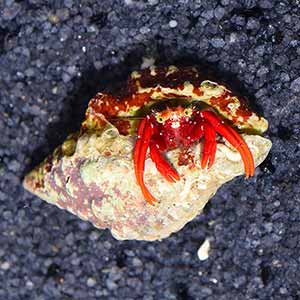
Scarlet Reef Hermit Crab
Algaes Known To Eat: Filamentous algae, hair algae, slime algae, cyanobacteria
Description
The Scarlet reef hermit crab is a hardy and popular saltwater algae eater. They have a huge appetite for algae and detritus. It has bold red legs and a lot of energy to eat nuisance algae, including hair and slime varieties. Unlike other hermit crabs, they are peaceful towards their tank mates.
Reef-Compatibility
Scarlet hermit crabs are reef safe, meaning they won’t attack corals. But they will attack snails or hermit crabs to get their shells. You can place many empty shells in the tank to discourage this behavior.
- Minimum Tank Size: 10 gallons
- Mature Size: 1.5 inches
- Care Difficulty: Easy
- Diet: Herbivore, Omnivore
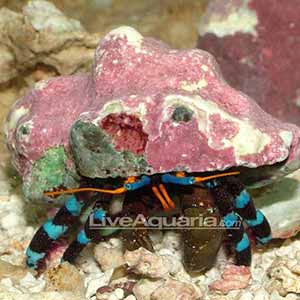
Electric Blue Hermit Crab
Algaes Known To Eat: Filamentous algae, hair algae, cyanobacteria
Description
The Electric blue hermit crab is a rare occurrence in the reef world. It has colorful blue legs with black banding that make it look great. With a big appetite for algae and a lot of energy, it will clean your tank from nuisance algae.
Reef-Compatibility
The Scarlet hermit crabs are reef safe, meaning they won’t attack corals. But they will attack snails or hermit crabs to get their shells. You can place many empty shells of various sizes in the tank to discourage this behavior.
- Minimum Tank Size: 10 gallons
- Mature Size: 2 inches
- Care Difficulty: Easy
- Diet: Omnivore
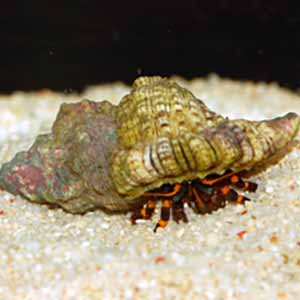
Orange Knuckle Hermit Crab
Algaes Known To Eat: Filamentous algae, cyanobacteria (red slime algae)
Description
The Orange knuckle hermit crab spends its time on the sandy floor, scavenging for food. This crab has black legs with tiny portions of bright orange. They are excellent algae cleaners, and they will aerate your sand substrate.
Reef-Compatibility
The Orange knuckle hermit crabs are reef safe, meaning they won’t attack corals. But they will attack snails or hermit crabs to get their shells. You can place many empty shells of various sizes in the tank to discourage this behavior.
- Minimum Tank Size: 24 gallons
- Mature Size: 2 inches
- Care Difficulty: Easy
- Diet: Omnivore
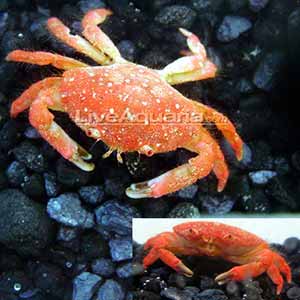
Strawberry Crab
Algaes Known To Eat: Green algae
Description
The Strawberry crab or Red boxing crab originates from Hawaii. It has a bright pink body with many tiny white spots, therefore resembling a strawberry. This crab has specialized front claws to pick up algae from the reef tank and keep it clean.
Reef-Compatibility
Strawberry crabs need plenty of live rock that they will keep clean and eat algae from. They also need to hide in crevices for safety. Will get along with most fish and invertebrates. As with all crabs, it might be aggressive with other crustaceans.
- Minimum Tank Size: 20 gallons
- Mature Size: 2 inches
- Care Difficulty: Easy
- Diet: Omnivore
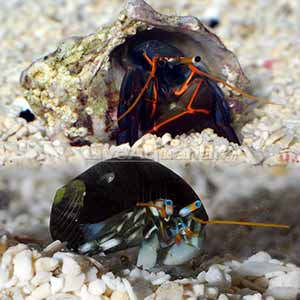
Zebra Hermit Crab
Algaes Known To Eat: Hair algae, film algae, cyanobacteria (red slime algae)
Description
The Zebra hermit crab is a beautiful addition to any reef tank, bringing a lot of colors and algae-cleaning energy. This algae eater’s body is black with white stripes, therefore its name.
Reef-Compatibility
The Zebra hermit crabs are reef safe, meaning they won’t attack corals. But they will attack snails or hermit crabs to get their shells. You can place many empty shells of various sizes in the tank to discourage this behavior.
- Minimum Tank Size: 10 gallons
- Mature Size: 1 inch
- Care Difficulty: Easy
- Diet: Herbivore